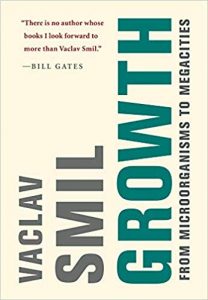I’ve been slowly reading Growth: From Microorganisms to Megacities by Vaclav Smil. Slowly only because of the size of the book, which means reading it at home. It’s a somewhat eccentric but really rather compelling read. The subtitle indicates its ambition. We do literally go from the growth dynamics of archaea and bacteria all the way to empires, with the common thread being the argument that physics places fundamental limits meaning that almost everything follows the logistic S curve and thus reaches an asymptote – although predicting where the points of inflection will occur is a different matter. “Natural growth taking place on earth is always limited.”
In the final section on economies, Smil quite rightly points out that even if measures of economic activity – notably GDP – remain non-stationary series, such activity is rooted in energy use – echoes here of his tremendous Energy and Civilization. Much of economics has ignored this, regarding early work on energy use in the economy – such as Georgescu-Roegen – as a bit weird, although this is perhaps changing with the onward march of environmental economics. Smil is more sceptical than I am about whether the process of dematerialization of economic growth has shifted the asymptote of the growth curve up and out; I don’t think the concept of sustainable consumption is empty, whereas he does. (Although when it comes to regarding ‘the Singularity’ as nonsense, he and I are at one). He concludes that unless there are strict limits on material consumption, human civilization is doomed, and one gets the firm impression he’s putting his money on doom.
However, the joy of this book is less in the big picture than in the detail. And what a lot of it! The mind boggles at Smil’s extensive reading and absorption of information. We get the speed at which marathons are run – over the entire course of human history; the growth rates of piglets and weight of chicekns over time; sales of small non-industrial motors over time; the envelope for the maximum speed of travel; Kuznets cycles; Zipf’s law for city size…. The middle section of chapters offer a fantastic overview of technical progress over long periods in a wide range of technologies. I love all this detail.
Growth is therefore a tremendous work of synthesis, the biggest of pictures in pointilist form. If Bill Gates hadn’t named Vaclav Smil as his favourite author (“I wait for new Vaclav Smil books the way some people wait for the next Star Wars movie.“), one could imagine him (Smil) as a character in a Borges story. Best of all is the passing comment that nearly all the calculations for all his post-1984 books have been done on a TI-35-Galaxy Solar calculator. Talk about sustainable consumption.
 Before embarking on Smil, we had a week of holiday so I read some non-work books, standout among them The Kites by Romain Gary, whose oeuvre I’m now racing through.
Before embarking on Smil, we had a week of holiday so I read some non-work books, standout among them The Kites by Romain Gary, whose oeuvre I’m now racing through.
